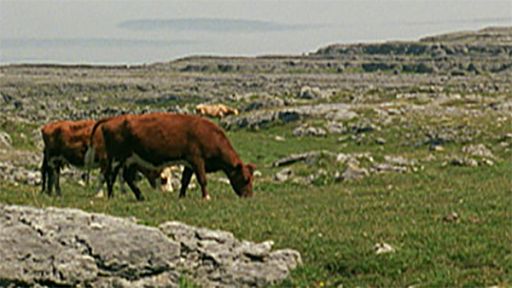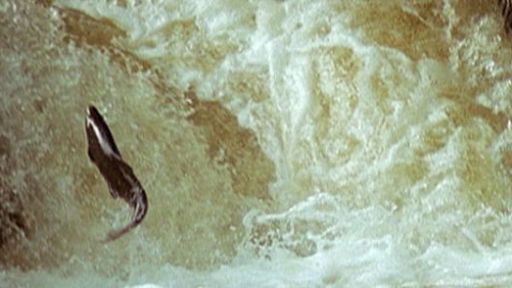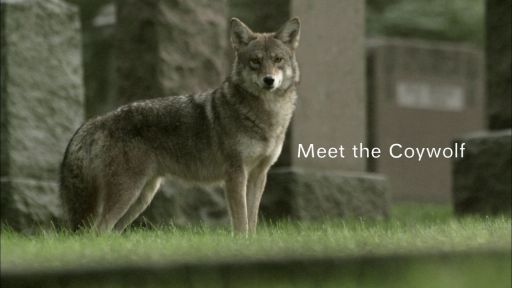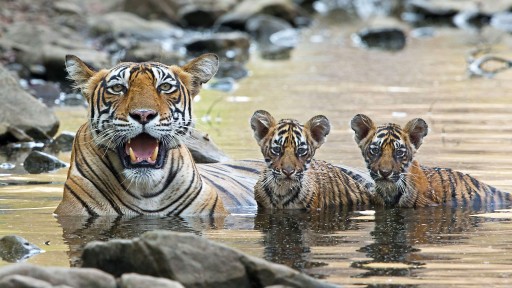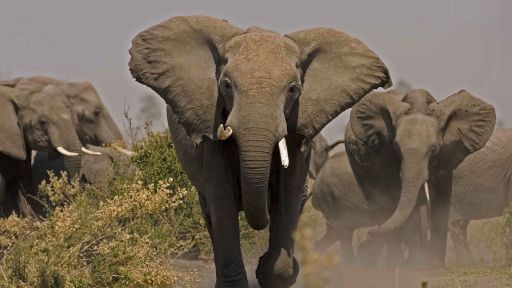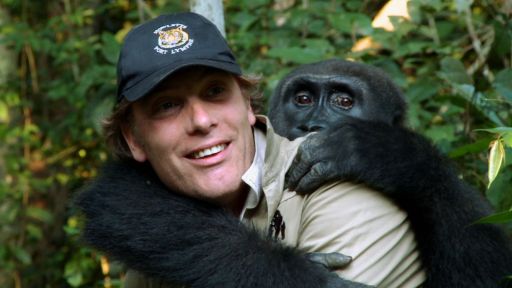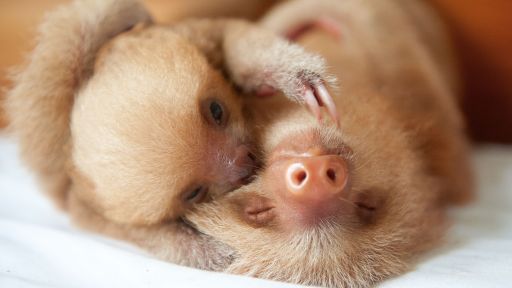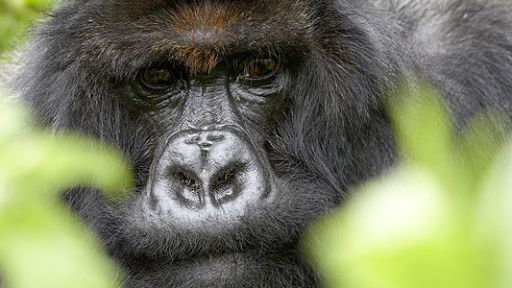TRANSCRIPT
[soft music] - [Narrator] Stand in any one of Ireland's cities and you're only a few miles from empty landscapes that seem untouched by time, lonely ocean shores, isolated mountains, wooded glens.
We may think of Ireland as an ancient world, but its many faces tell a different story.
What is old to us, is still young to the land.
Many forces have combined to form this wild mosaic of landscapes and the plants and animals that live in them today.
Ireland has been shaped by nature, and by man, but it's time that holds the key to its secrets.
- [Announcer] This program was made possible by the Corporation for Public Broadcasting and by contributions to your PBS station from viewers like you, thank you.
- [Narrator] This is the only horse race in the world to be run at the edge of the sea.
Held once a year on Laytown Beach, near Dublin, it reflects Ireland's centuries-old love affair with the horse.
Man has bred these horses for speed and endurance.
He has left his own mark on what time and nature have already made, just as he helped to mold the Irish landscape, animals and plants.
And before humans, older, more profound forces were at work.
This ancient land might seem timeless, but change lies at its very heart.
Ireland has rarely stood still Ireland's hills and mountains are formed from her oldest, hardest rocks, they're part of the legacy of her geological past, the foundation on which this island is built.
But the landscapes we see today have more recent origins.
Everywhere, Ireland has been sculpted in some way by one of the greatest forces of nature, ice.
For almost 2 million years, Ireland, like the rest of Europe, was locked in the grip of the Ice Age.
Glaciers, vast moving sheets of ice, destroyed nearly all life and transformed the contours of the land.
No part of Ireland completely escaped their impact.
In the Mountains of Mourne in Northern Ireland, the glaciers never quite reached the summits, but the cold they carried with them did.
Frost action split and shattered the rock faces, chiseling steep ravines and deeply carved peaks.
One bird of the mountains has made the most of this ice age legacy.
The peregrine falcon comes to the Mournes to nest.
[birds chirping] Remote rock faces and inaccessible ledges are the safest place to raise their chicks and the land around provides good hunting for the adults.
All good reasons why there are more peregrines here than anywhere else in Ireland.
But even peregrines couldn't have lived here until the Ice Age ended, around 13,000 years ago.
Exactly when they staked their claim to Ireland's uplands isn't clear, but since then, their fortunes, like everything else here, have changed with the times.
Today they're widespread throughout the country, but less than 40 years ago, peregrines hit an all-time low.
Poisoned by insecticides designed to protect seeds and crops, their numbers dived to just 27 successful nesting pairs, bringing them perilously close to extinction.
Only when the chemicals were banned did the peregrines' recovery begin.
It's been a slow process but they're now thriving, and reclaiming the mountain landscape they inherited from the ice.
Ireland's Mountains lie scattered around her edge, encircling a watery landscape of rivers, streams, lakes, fens and bogs.
On her west coast in County Mayo stands Ireland's most sacred mountain, Croagh Patrick.
On this summit, Ireland's patron saint is believed to have fasted for 40 days and nights, and today, more than 1500 years later, the mountain remains a place of pilgrimage.
Every year on Reek Sunday, the last Sunday in July, more than 25,000 people follow in Saint Patrick's footsteps.
As the pilgrims make the steep descent, the view before them is another with its feet in the Ice Age, Clew Bay.
Whale-backed islands are a testimony to the power of glaciers.
Stones and soil were trapped beneath their massive weight and molded into mini hills called drumlins.
Then, when the ice retreated and sea levels rose, these glacial relics were partly submerged, creating a drowned landscape.
In this water world, even the sheep are shepherded by boat, in traditional curraghs, powered by modern outboard motors.
The popular belief is that there are 365 islands in Clew Bay, one for each day of the year.
They're sheltered from the more extreme conditions of the North Atlantic and their rocky shorelines are a sanctuary for common seals.
Clew Bay is one of those corners of Ireland that does feel frozen in time.
Whole communities once carved a living from these islands, Animals grazed and homesteads grew up around small sheltered bays.
But famine drove many away and changing times have made this kind of life uneconomic today.
Only seven of the islands are still inhabited.
There are ghosts of past lives all along this stretch of coast.
Rockfleet castle was one of many belonging to Grace O'Malley, Queen of the Clew Bay pirates who ruled these waters in the 16th Century.
The network of tiny isles and bays provided ideal hideaways for the pirate galleys that plundered passing ships.
It's hard to imagine such a turbulent past, all that's likely to disturb these waters today are otters, hunting for food.
These shy, elusive creatures live in most of Ireland's lakes and rivers; there are more here than in any other part of Europe, but on the West Coast, they're equally at home in the sea, fishing and playing close to shore.
Pups first take the plunge when they're around two and half months old.
They stay with their mother for around a year, until they've learned enough hunting and social skills to strike out on their own.
Fish are the otters' main prey, but crabs are always a tasty alternative.
In the chilly Atlantic waters, plenty of play and a well-groomed waterproof fur coat keep the otters warm.
Like the peregrine falcon, the otter would have been part of Ireland's post-Ice Age landscape.
But just how they and all the plants and animals we see today got here once the ice had gone is still a mystery.
Some may have survived in ice-free areas.
Some probably migrated from Europe.
But among the first to enter this new world was a fish with a head start, the salmon.
Able to survive in both salt and fresh water meant that as the glaciers retreated north, salmon cruising around the coastline could make their way up the new rivers that now flowed into the sea.
Since then, for 10,000 years or more, salmon have been making the same trip.
These fish have spent one or more winters feeding at sea, building up enough bulk to return to the place they were spawned to breed themselves.
It's a long, often treacherous journey, but the salmon are following an instinct impossible to resist.
Once they enter freshwater, the salmon stop feeding.
Their only source of energy now is the body mass they gained at sea.
Deep river pools give them a chance to rest along the way.
In the wake of the ice, Ireland's rising waterways provided opportunities for birds like the dipper.
Drawn in by the insects they fed on, dippers made themselves at home among the boulders of shallow, fast-flowing streams.
The dippers here today may be descended from their European relatives, but they've evolved into a true Irish sub-species with a tell-tale chestnut belly.
The melting Ice Age left behind a land laid bare of life, but linked, for a while at least, to the rest of Europe.
Many of the first colonizers, tough pioneers like grasses, sorrels, flowering plants and shrubs, traveled to Ireland across these early land bridges.
Following in their footsteps, came the trees.
The sessile oak put in a late appearance, but its range quickly expanded to take in much of the Irish landscape.
Mixed with hazel, elm, and alder, it then dominated Ireland's woodlands for around 2,000 years.
Where the soil was too shallow and limey for oak, another tree ruled, the yew.
Today yew is the only native Irish conifer remaining from that early time, and the finest natural remnant of these woodlands is found on a limestone outcrop in Killarney National Park in the south west corner of Ireland.
If the little people do exist, this is where they'd be.
Killarney National Park also lays claim to Ireland's largest land mammal.
Together with other forest animals, red deer traveled with the advancing woodlands.
The Killarney deer appear to be a genetically distinct race and many say they're the only Irish red deer who are truly native.
Rather more common and widespread among Ireland's mammals is the badger.
Extremely sociable, badgers live in small groups led by a single male, and spend their days rooting mainly for earthworms and the occasional insect.
Along with the red squirrel, they would once have lived throughout the forests that covered much of Ireland.
Nowadays, with most of these woodlands gone, badgers are forced to dig their underground homes on the edge of farmland, in the earth banks of hedgerows and trees.
This nimble relative of badgers is the pine marten.
It's Ireland's most elusive mammal, rarely spotted in the wild.
But it's also an opportunist, and can be tempted closer with the right bait, food!
It has very muscular front limbs, providing power and dexterity for climbing trees, and bird feeders.
Pine martens will eat anything from eggs to earthworms, beetles to biscuits.
But appetite must be tempered by caution.
While many plants and animals made it across to Ireland from Europe, some did not.
But what happened to stop them?
Off Ireland's East Coast lies a clue, the remnants of a forest 6,000 years old.
It once stood on a patch of dry land that, earlier still, would have been attached to Britain.
But as the Ice Age glaciers melted, vast amounts of water were released and sea levels rose.
Eventually, all the land bridges linking Ireland to the mainland were breached.
For land migrants crossing to Ireland, it would have been a race against time.
The stoat managed to beat the rising waters, while its smaller cousin, the weasel, never made it to Ireland.
Those early stoats would have discovered little other life.
Prey for these tiny, but voracious hunters would have been scarce on the ground and they may have been drawn to richer pickings along the coast.
Here they could hunt or scavenge along the shoreline.
Some stoats are still beachcombers today.
They need to be.
Frogs were latecomers, and no moles or snakes ever made it to Ireland for the stoats to prey upon.
The seas rose and made Ireland an island before they could get here.
But traveling by sea, the first people arrived in Ireland some 9,000 years ago.
They were the next big force to shape Irelands history.
At first, impenetrable forest kept them mostly confined to the coast.
Ancient middens contain the remains of prehistoric oyster feasts.
Ireland's coastal waters were rich in life and would have provided early settlers with a good living.
Native Irish flat oysters were an important food, they required no cultivation, were easy to harvest in the shallow waters and limitless in supply.
An oyster bed is one of the densest concentrations of animal life on the planet.
Here it attracts huge numbers of scavenging shore crabs, but enough shellfish survive to make oysters a good economic proposition.
The Kelly family has been farming oysters in this sheltered inlet of Galway Bay for half a century.
Diarmuid Kelly now manages the family business.
- People have been eating oysters for thousands of years.
They were one of the first things you could eat when people came to inhabit the shores here.
People along the coast, they also benefited during the famine.
They had the benefit of eating oysters and mussels to keep them alive and keep their families alive during those difficult times.
- [Narrator] The Kelly's raise their oysters on special fattening beds, where they grow plump and develop their own unique flavor.
- To the west we have the Atlantic, to the east we have the Field of Athenry and the freshwater coming in from the Dunkellin and the Clarin.
So the mixture with the Atlantic flushing in twice a day concentrating the flavor and you really have the essence of the Ocean.
- [Narrator] Every year, the Kellys supply around 100,000 oysters to the Galway Bay Oyster Festival.
Founded in 1954, this is Ireland's longest running festival and draws oyster lovers from all over the world to taste the cream of Galway's oyster crop.
[upbeat Irish music] And it's all washed down with one of Ireland's other claims to fame of course.
The Galway Oyster Festival provides the stage for the World Oyster Opening Championships.
Competitors come from all over the world to see who can open 30 oysters in the shortest time.
- [Crowd] 3, 2, 1!
[upbeat Irish music] - [Announcer] And the world oyster opening champion for 2013, from Sweden, [indistinct] - [Narrator] Since they arrived in Ireland, people have become the driving force behind the evolution of the landscape.
In the north west corner of County Clare lies one of Ireland's most enigmatic landscapes, the Burren.
First impressions are of a natural wilderness, untouched by Man.
Three-quarters of Ireland's native plant species are found in the Burren, yet it covers less than one percent of the country.
But appearances may be deceptive.
The Burren is unique, but it's not strictly natural, it's been sculpted by generations of people, their livestock and traditions.
The Burren takes its name from the Gaelic word for stony place, after its characteristic exposed limestone.
Millions of years ago, ancient seas covered the area, and this rock was formed from the remains of calcium-rich shellfish and corals.
Much later, the shifting glaciers of the Ice Age helped to shape the Burren, scouring and gouging the dramatic limestone outcrops, depositing fertile soils along valleys and hillsides and carrying giant boulders over huge distances before discarding them at random.
Water has played its part too, finding its way into minute fissures and joints and eating away at the soft limestone to scoop out hollows, grooves, pits and great gullies known as grykes.
But, more than anything else, it's the lives of generations of people that have really created what we see today.
As far back as 6,000 years ago, Neolithic farmers were leaving their mark.
They began to clear the great woodlands that covered the area.
They grazed their animals and began to cultivate the soil.
Many of the Burren's stone walls are thousands of years old.
Today, they show us how these early farmers marked ownership and divided land, in an area where the population was growing fast.
Great megalithic tombs made from limestone hewn from the surrounding landscape are reminders that these settlers also honored generations of their dead.
The Burren has one of the densest concentrations of prehistoric burial sites anywhere in Ireland.
Some date back almost 6,000 years and some were used continually for a millennium or more.
But even though this place was densely populated, excavations have revealed the tombs account for only a relatively small percentage of this population.
So where were those not granted burial here laid to rest?
The Burren has been slow to give up its secrets, but archeologist Christine Grant believes she's on the verge of a discovery, a form of burial never seen here before, one that made use of what the landscape had to offer, a deep, natural cleft in the limestone rock.
- So if we can take this skull, it's in very good condition.
Unfortunately, we don't have the lower jaw, which is always a good way to tell if it's male or female, but the brow ridge seems to be quite steep, so it's more likely to be female.
When you first discover a burial like this or see it for the first time, it is actually quite moving, quite touching to think this was an actual person who lived here possibly thousands of years ago and this is where they spent their life time.
And you have to wonder what were they like?
What was their daily life like?
What was the area like back then?
Was life hard for them?
How did they die and why?
As a female myself, I can identify in a different way with it and wonder what was a woman's life like back then.
At the end of the day, that's what we're trying to find out.
It's about the people, it's about what their life was like.
That's what archeology is.
So we have to get away from the form of the burial and what the bones tell us back into the person themselves.
And that's what we're after.
- [Narrator] Glimpses of past lives are always visible in the present, in the living of today, in the traditions passed down through the generations.
Upland areas normally make good grazing in the summer, but in the Burren, livestock are driven up on to the high limestone tops in early winter.
The limestone rock absorbs the heat of the summer sun and, like a giant storage heater, releases it in winter, boosting the ground temperature.
This coupled with the winter rainfall that provides water in an otherwise arid landscape guarantees grazing when elsewhere there is little to eat.
For centuries, this grazing regime has kept scrub and tall grasses at bay, and helped keep the landscape open, allowing many of the flowers for which the Burren is famous to flourish.
The beauty of the Burren springs partly from farming traditions begun thousands of years ago.
Without the grazing animals, grasses, scrub and then trees would take over once more, and this unique rock garden of flowers would gradually disappear.
Deserted farmsteads and churches stand like ghostly witnesses to the past custodians of this landscape.
But it's the living who now hold the future of the Burren in their hands.
Modern economics and farming practices are changing age-old traditions, yet these traditions must somehow survive if this special little corner of Ireland is to be kept alive.
No landscape stays the same forever.
Change is an inevitable part of any world.
And even those places that seem most timeless, Ireland's wild boglands, hide surprising glimpses of a past very unlike their present.
Bogs are made largely of peat or turf, the partly rotted remains of plants.
The rotting process is never completed because the bogs are saturated with water for much or all of the year.
Only a few specialized plants can survive these wet conditions, and as they die, they top up the peat.
Eventually, the peat layer becomes so thick that it cuts off the supply of minerals in the soil below, so new plants on the surface have to feed themselves in other ways.
Some, like the sundew, have become carnivorous, trapping and digesting passing insects.
The potassium, nitrogen and phosphorous in the insects' bodies sustain the plants and help them grow.
Bogs are etched deeply into the physical landscape [goats bleeping] and into human lives, and they've always been part of the rural economy.
Bogs cover one-sixth of Ireland's land area, and even now remain an abundant source of fuel.
But for one archeologist, they're also a source of information about the past.
Seamas Caulfield has spent 30 years studying one special area of bog in north County Mayo.
Digging peat, he unearthed a secret the bog had kept hidden for thousands of years.
- Well, I'm cutting turf here, I've cut down through 5,000 years of plant remains.
These plants grew in the 3rd millennium AD.
The plant remains at the bottom grew 5,000 years ago, and they grew beside and then on top of this stone wall.
And some of these stones I've just uncovered have not been seen for 5,000 years.
- [Narrator] These stones are part of the Ceide Fields, meaning "fields of the flat-topped hill."
They're all that's left of a landscape created by people five and a half thousand years ago, only to be overtaken by nature less than 500 years later.
These stones surrounded large fields in which cattle grazed, were used to build homes for the living and tombs to honor the dead.
The people who lived here were Neolithic, Ireland's earliest farmers.
Working together, they outlined an agricultural landscape covering more than five square miles.
- They must have been organized to be able to make the decision that they would lay out the fields over such a very extensive area.
And then they must have been highly organized to be able to go and do that, because there's about a quarter of a million tons of stone in the walls themselves.
- [Narrator] This was a sizeable and peaceful population, as deeply rooted in the landscape as any farming community today.
- And what we often ignore, of course, is that people lived, raised their children, children ran across the fields to the children a few hundred yards away in the next house, fell over the walls and cut their knees.
They were simply living but living, I would think, in peaceful, in happy conditions there, probably more comfortably than people did a century ago in many parts of Ireland.
- [Narrator] But these Neolithic farmers were here for no more than a few hundred years, before they were driven out by a force they couldn't control.
It seems the climate changed dramatically and the levels of the bogs rose, and swallowed everything they had made, preserving it forever in the past.
[waves crashing] Climate and the sea combined to help shape Ireland's fortunes.
The Gulf Stream, a warm ocean current, has brought richness to her western shores.
Here the lush growth of seaweed has been harvested for centuries.
Around Connemara, it's still cut in the traditional way using hooks and sickles.
In the past, it was used to fertilize poor coastal soils, to prepare the ground for planting potatoes, but now most goes in to the cosmetics industry.
The Gulf Stream carries its warm waters all the way across the cold Atlantic from the Caribbean.
Along Ireland's west coast, it mixes with the cooler, nutrient-rich upwellings, laying the foundation of a hugely productive food chain.
This seafood cocktail draws the biggest, heaviest seabirds in the North Atlantic, gannets, quick to take advantage of the trawlers' overflow.
[seagulls cawing] Gannet numbers have boomed in recent years, no doubt helped by this plentiful supply of food.
They also find safe nest sites on the offshore islands, and Ireland is home to some of Europe's largest seabird colonies.
This is Skellig Michael, seven sea miles off the coast of County Kerry down in Ireland's South West corner.
It's a sanctuary for a much smaller bird, the puffin.
Thousands of puffins arrive in early spring to breed and stay throughout the summer.
The puffins normally return with the same partner, to the same nest burrow, although it may need redecorating after the winter.
In the summer months, the puffins share the island with thousands of tourists, most of whom come to visit Skellig Michael's ruined monastery.
They climb 600 steps that lead up to the island's northern pinnacle, 600 feet above sea level.
This small enclosure of stone huts and oratories was founded in the early days of Christianity, in the 6th Century.
But how the monks survived here on this barren, storm-swept crag remains a mystery.
Skellig Michael's neighboring island, Little Skellig, is accessible only to birds, and is the 4th largest gannetry in the world.
But with 58,000 breeding adults, there are no more vacancies.
Young gannets that would normally return to breed here have been forced to look farther afield.
They've moved east along Ireland's southern coast to Great Saltee Island, County Wexford.
The first pair of gannets arrived here in 1929, but it took 30 years for numbers to reach double figures.
More recently, as surplus birds from Little Skellig have moved in, Great Saltee's gannet population has soared.
Gannets mate for life, so pairs may be together for up to 20 years.
Complex courtship and preening rituals reinforce the couple's bonds.
Like the puffins, gannet pairs usually return to the same nest each breeding season.
It's really just a mound of rotten vegetation, lined afresh each year with new seaweed, grasses and feathers.
The chicks are fed regurgitated fish and have gargantuan appetites.
The parents take turns, one remaining with the chick while the other flies back out to sea to hunt for the next meal.
Ireland's rich coastal waters lure in other fish eaters, bottlenose dolphins.
One group has settled permanently in the estuary of the Shannon, Ireland's longest river.
Stories of mermaids and sea serpents here go back centuries, suggesting these dolphins may have been here for a very long time.
The Gulf Stream brings warm winters to Ireland and the prevailing winds off the Atlantic carry with them rain.
It means grass can grow almost all year round, creating the lush sweeping pastures of the Emerald Isle.
Today they make up 93% of all farmland.
No other country in Europe has quite as much grass as Ireland.
[cow moos] Most of Ireland's grass goes to her sheep and cattle, but in County Kildare, another animal dominates this green backdrop, the horse.
The ancient grasslands of the Curragh are renowned for their high quality grazing.
The underlying limestone's good for bone formation, and the grass is especially sweet.
It's a link that goes back a long way.
In the 12th Century, the monks of the Knights of Malta bred war-horses here.
Today, it isn't war, but racing that's become the symbol of the Curragh.
The area is home to a multi-million dollar bloodstock industry.
In 1900, Colonel William Hall-Walker, of the wealthy Scottish brewery, set up the Irish National Stud.
As well as the good grazing, he believed the River Tully's mineral-rich water would contribute to his horses' health and strength.
The stud quickly became one of the finest of its kind in Europe, building up a stable of mares and stallions that revolutionized racing in Ireland.
Today that influence extends far wider.
Some of the finest horses in the world are bred, trained and raced on the Curragh, on the cream of Ireland's ancient grasslands.
Another unique Irish grassland, very different from the Curragh, lies beside the middle section of the river Shannon.
The Shannon's shallow gradient slows down its flow so much, its waters struggle to make their escape to the sea.
Every winter, the river floods surrounding fields to create Ireland's largest area of seasonally flooded meadows, the Shannon Callows, diverse grasslands that have all, but disappeared throughout much of Europe.
The Shannon's waters have proved so difficult to tame that few bridges were ever built across the floodplains.
Today, at Banagher, nesting house martins make good use of one of them.
This ancient landscape is the setting of the Monastery of Clonmacnoise.
Founded in 548, it was a bastion of Irish religion, literature and art at a time when much of Europe languished in the Dark Ages.
For almost 1500 years, it has looked out across the changing Callows landscape.
These faces witnessed the felling of the swamp woodland that once lay all around, but also the ongoing cycle of the rising and falling waters..
In spring, the floods recede to reveal the fresh, damp meadowlands.
Wading birds arrive to breed and raise their young.
Redshank bathe in small pools left behind by the disappearing waters.
[birds chirping] Lapwing are the earliest to lay their eggs, nestling into a small scrape in the ground.
But the curlew is too big to hide, she must rely on silence, camouflage and the growing grass around her for protection.
Nutrients carried in the Shannon's winter floodwaters help to make some of Ireland's richest summer grazing.
[cow moos] Cattle are driven across the river to rich island pastures that appear as the floods recede.
[soft music] The Callows are home to rare native flowers and plants, rooted in soil that's never been ploughed or re-sown.
But this place isn't a completely natural landscape.
Much of this beauty depends on traditional management, like the annual hay cut in late summer.
Without the hand of man, much of this lush variety would disappear.
Thanks to the untamable flooding of the River Shannon, the Callows has been able to resist some of the profound changes that have transformed other parts of Ireland.
All of Ireland is entwined with human history, but it's hard to say whether the story has been long or short.
From ice and stone to fields of green, Ireland has witnessed change in dramatic measure and made them her own.
- [Announcer] This program was made possible by the Corporation for Public Broadcasting and by contributions to your PBS station from viewers like you, thank you.

